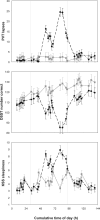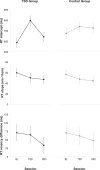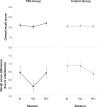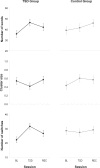Effects of sleep deprivation on dissociated components of executive functioning
- PMID: 20120620
- PMCID: PMC2802247
- DOI: 10.1093/sleep/33.1.47
Effects of sleep deprivation on dissociated components of executive functioning
Abstract
Study objectives: We studied the effects of sleep deprivation on executive functions using a task battery which included a modified Sternberg task, a probed recall task, and a phonemic verbal fluency task. These tasks were selected because they allow dissociation of some important executive processes from non-executive components of cognition.
Design: Subjects were randomized to a total sleep deprivation condition or a control condition. Performance on the executive functions task battery was assessed at baseline, after 51 h of total sleep deprivation (or no sleep deprivation in the control group), and following 2 nights of recovery sleep, at fixed time of day (11:00). Performance was also measured repeatedly throughout the experiment on a control task battery, for which the effects of total sleep deprivation had been documented in previously published studies.
Setting: Six consecutive days and nights in a controlled laboratory environment with continuous behavioral monitoring.
Participants: Twenty-three healthy adults (age range 22-38 y; 11 women). Twelve subjects were randomized to the sleep deprivation condition; the others were controls.
Results: Performance on the control task battery was considerably degraded during sleep deprivation. Overall performance on the modified Sternberg task also showed impairment during sleep deprivation, as compared to baseline and recovery and compared to controls. However, two dissociated components of executive functioning on this task--working memory scanning efficiency and resistance to proactive interference--were maintained at levels equivalent to baseline. On the probed recall task, resistance to proactive interference was also preserved. Executive aspects of performance on the phonemic verbal fluency task showed improvement during sleep deprivation, as did overall performance on this task.
Conclusion: Sleep deprivation affected distinct components of cognitive processing differentially. Dissociated non-executive components of cognition in executive functions tasks were degraded by sleep deprivation, as was control task performance. However, the executive functions of working memory scanning efficiency and resistance to proactive interference were not significantly affected by sleep deprivation, nor were dissociated executive processes of phonemic verbal fluency performance. These results challenge the prevailing view that executive functions are especially vulnerable to sleep loss. Our findings also question the idea that impairment due to sleep deprivation is generic to cognitive processes subserved by attention.
Figures





References
-
- Durmer JS, Dinges DF. Neurocognitive consequences of sleep deprivation. Semin Neurol. 2005;25:117–29. - PubMed
-
- Phillips LH. Do “frontal tests” measure executive functions? Issues of assessment and evidence from fluency tests. In: Rabbitt P, editor. Methodology of frontal and executive function. Hove: Psychology Press; 1997. pp. 191–213.
-
- Overtoon C. Employability skills: An update. Columbus: Clearinghouse on Adult, Career, and Vocational Education; 2000.
-
- Harrison Y, Horne JA. The impact of sleep deprivation on decision making: a review. J Exp Psychol Appl. 2000;6:236–49. - PubMed
Publication types
MeSH terms
LinkOut - more resources
Full Text Sources

